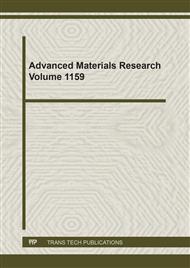[1]
Masanta, M., Shariff, S. M., & Choudhury, A. R.: A comparative study of the tribological performances of laser clad TiB2–TiC–Al2O3 composite coatings on AISI 1020 and AISI 304 substrates. Wear, (2011), 271(7-8), 1124-1133.
DOI: 10.1016/j.wear.2011.05.009
Google Scholar
[2]
Prince, M., Thanu, A. J., & Gopalakrishnan, P.: Improvement in wear and corrosion resistance of AISI 1020 steel by high velocity oxy-fuel spray coating containing Ni-Cr-B-Si-Fe-C. High temperature materials and processes, (2012), 31(2), 149-155.
DOI: 10.1515/htmp-2012-0009
Google Scholar
[3]
Davis, J. R. (Ed.). Surface engineering for corrosion and wear resistance. ASM international (2001).
Google Scholar
[4]
Fan, L., Chen, H. Y., Dong, Y. H., Dong, L. H., & Yin, Y. S.: Wear and corrosion resistance of laser-cladded Fe-based composite coatings on AISI 4130 steel. International Journal of Minerals, Metallurgy, and Materials, (2018), 25(6), 716-728.
DOI: 10.1007/s12613-018-1619-2
Google Scholar
[5]
Sun, Y., & Bell, T.: Plasma surface engineering of low alloy steel. Materials Science and Engineering: A, (1991), 140, 419-434.
DOI: 10.1016/0921-5093(91)90458-y
Google Scholar
[6]
Nazir, M. H., Khan, Z. A., Saeed, A., Siddaiah, A., & Menezes, P. L.: Synergistic wear-corrosion analysis and modelling of nanocomposite coatings. Tribology International, (2018). 121, 30-44.
DOI: 10.1016/j.triboint.2018.01.027
Google Scholar
[7]
Rother, B., Kappl, H., Pfeifer-Schäller, I., Ebersbach, G., & Jehn, H. A.: Property distribution on three-dimensionally shaped PVD-coated samples. Surface and Coatings Technology, (1997). 97(1-3), 200-203.
DOI: 10.1016/s0257-8972(97)00135-7
Google Scholar
[8]
Rother, B., Kappl, H., Pfeifer-Schäller, I., Ebersbach, G., & Jehn, H. A.: Property distribution on three-dimensionally shaped PVD-coated samples. Surface and Coatings Technology, (1997), 97(1-3), 200-203.
DOI: 10.1016/s0257-8972(97)00135-7
Google Scholar
[9]
Dyuti, S., Mridha, S., & Shaha, S. K.: Surface modification of mild steel using tungsten inert gas torch surface cladding. American Journal of Applied Sciences, (2010), 7(6), 815.
DOI: 10.3844/ajassp.2010.815.822
Google Scholar
[10]
Ming, Q., Lim, L. C., & Chen, Z. D.: Laser cladding of nickel-based hard facing alloys. Surface and Coatings Technology, (1998), 106(2-3), 174-182.
DOI: 10.1016/s0257-8972(98)00524-6
Google Scholar
[11]
Sharifitabar, M., Khaki, J. V., & Sabzevar, M. H.: Microstructure and wear resistance of in-situ TiC–Al2O3 particles reinforced Fe-based coatings produced by gas tungsten arc cladding. Surface and Coatings Technology, (2016), 285, 47-56.
DOI: 10.1016/j.surfcoat.2015.11.019
Google Scholar
[12]
Pradeep, G. R. C., Ramesh, A., & Prasad, B. D.: Hard facing of AISI 1020 Steel by Arc Welding in Comparison with TIG Welding Processes. Journal of Scientific Research, (2013), 5(1), 119-126.
DOI: 10.3329/jsr.v5i1.11899
Google Scholar
[13]
Du, B., Zou, Z., Wang, X., & Qu, S.: Laser cladding of in situ TiB2/Fe composite coating on steel. Applied Surface Science, (2008), 254(20), 6489-6494.
DOI: 10.1016/j.apsusc.2008.04.051
Google Scholar
[14]
Sahoo, C. K., Soni, L., & Masanta, M.: Evaluation of microstructure and mechanical properties of TiC/TiC-steel composite coating produced by gas tungsten arc (GTA) coating process. Surface and Coatings Technology, (2016), 307, 17-27.
DOI: 10.1016/j.surfcoat.2016.08.056
Google Scholar
[15]
Hojjatzadeh, S. M. H., Halvaee, A., & Sohi, M. H.: Surface alloying of AISI 1045 steel in a nitrogen environment using a gas tungsten arc process. Journal of Materials Processing Technology, (2012), 212(11), 2496-2504.
DOI: 10.1016/j.jmatprotec.2012.06.006
Google Scholar
[16]
Sharifitabar, M., Khaki, J. V., & Sabzevar, M. H.: Microstructure and wear resistance of in-situ TiC–Al2O3 particles reinforced Fe-based coatings produced by gas tungsten arc cladding. Surface and Coatings Technology, (2016), 285, 47-56.
DOI: 10.1016/j.surfcoat.2015.11.019
Google Scholar


